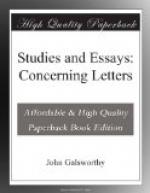But let me take an illustration of what I mean by these two kinds of finality that Art may have, and show that in essence they are but two halves of the same thing. The term “a work of Art” will not be denied, I think, to that early novel of M. Anatole France, “Le Lys Rouge.” Now, that novel has positive finality, since the spiritual conclusion from its premises strikes one as true. But neither will the term “a work of Art” be denied to the same writer’s four “Bergeret” volumes, whose negative finality consists only in the temperamental atmosphere wherein they are soaked. Now, if the theme of “Le Lys Rouge” had been treated by Tolstoy, Meredith, or Turgenev, we should have had spiritual conclusions from the same factual premises so different from M. France’s as prunes from prisms, and yet, being the work of equally great artists, they would, doubtless, have struck us as equally true. Is not, then, the positive finality of “Le Lys Rouge,” though expressed in terms of a different craftsmanship, the same, in essence, as the negative finality of the “Bergeret” volumes? Are not both, in fact, merely flower of author true to himself? So long as the scent, colour, form of that flower is strong and fine enough to affect the senses of our spirit, then all the rest, surely, is academic—I would say, immaterial.
But here, in regard to Art, is where mankind at large comes on the field. “‘Flower of author,’” it says, “‘Senses of the spirit!’ Phew! Give me something I can understand! Let me know where I am getting to!” In a word, it wants a finality different from that which Art can give. It will ask the artist, with irritation, what his solution, or his lesson, or his meaning, really is, having omitted to notice that the poor creature has been giving all the meaning that he can, in every sentence. It will demand to know why it was not told definitely what became of Charles or Mary in whom it had grown so interested; and will be almost frightened to learn that the artist knows no more than itself. And if by any chance it be required to dip its mind into a philosophy that does not promise it a defined position both in this world and the next, it will assuredly recoil, and with a certain contempt say: “No, sir! This means nothing to me; and if it means anything to you—which I very much doubt—I am sorry for you!”
It must have facts, and again facts, not only in the present and the past, but in the future. And it demands facts of that, which alone cannot glibly give it facts. It goes on asking facts of Art, or, rather, such facts as Art cannot give—for, after all, even “flower of author” is fact in a sort of way.
Consider, for instance, Synge’s masterpiece, “The Playboy of the Western World!” There is flower of author! What is it for mankind at large? An attack on the Irish character! A pretty piece of writing! An amusing farce! Enigmatic cynicism leading nowhere! A puzzling fellow wrote it! Mankind at large has little patience with puzzling fellows.




